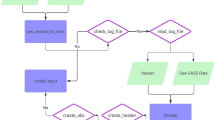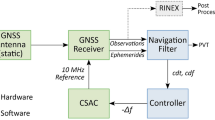Abstract
A joint-processing model for multi-GNSS (GPS, GLONASS, BDS and GALILEO) precise point positioning (PPP) is proposed, in which raw code and phase observations are used. In the proposed model, inter-system biases (ISBs) and GLONASS code inter-frequency biases (IFBs) are carefully considered, among which GLONASS code IFBs are modeled as a linear function of frequency numbers. To get the full rank function model, the unknowns are re-parameterized and the estimable slant ionospheric delays and ISBs/IFBs are derived and estimated simultaneously. One month of data in April, 2015 from 32 stations of the International GNSS Service (IGS) Multi-GNSS Experiment (MGEX) tracking network have been used to validate the proposed model. Preliminary results show that RMS values of the positioning errors (with respect to external double-difference solutions) for static/kinematic solutions (four systems) are 6.2 mm/2.1 cm (north), 6.0 mm/2.2 cm (east) and 9.3 mm/4.9 cm (up). One-day stabilities of the estimated ISBs described by STD values are 0.36 and 0.38 ns, for GLONASS and BDS, respectively. Significant ISB jumps are identified between adjacent days for all stations, which are caused by the different satellite clock datums in different days and for different systems. Unlike ISBs, the estimated GLONASS code IFBs are quite stable for all stations, with an average STD of 0.04 ns over a month. Single-difference experiment of short baseline shows that PPP ionospheric delays are more precise than traditional leveling ionospheric delays.




















Similar content being viewed by others
References
Al-Shaery A, Zhang S, Rizos C (2013) An enhanced calibration method of GLONASS inter-channel bias for GNSS RTK. GPS Solut 17(2):165–173
Banville S, Collins P, Lahaye F (2013) GLONASS ambiguity resolution of mixed receiver types without external calibration. GPS Solut 17(3):275–282
Bisnath S, Gao Y (2007) Current state of precise point positioning and future prospects and limitations. Observing our changing planet. IAG Symp 133:615–624
Cai C, Gao Y (2007) Precise point positioning using combined GPS and GLONASS observations. J Glob Position Syst 6(1):13–22
Cai C, Gao Y (2013) Modeling and assessment of combined GPS/GLONASS precise point positioning. GPS Solut 17(2):223–236
Chen J, Xiao P, Zhang Y, Wu B (2013) GPS/GLONASS system bias estimation and application in GPS/GLONASS combined positioning. In: China satellite navigation conference (CSNC) 2013 Proceedings, pp 323-333
Chuang S, Wenting Y, Weiwei S, Yidong L, Rui Z (2013) GLONASS pseudorange inter-channel biases and their effects on combined GPS/GLONASS precise point positioning. GPS Solut 17(4):439–451
Colombo OL (2008) Real-time, wide-area, precise kinematic positioning using data from internet NTRIP streams. In: Proceedings of ION-GNSS-2008. Institute of Navigation, Savannah, Georgia, pp 327–337
Defraigne P, Baire Q (2011) Combining GPS and GLONASS for time and frequency transfer. Adv Space Res 47(2):265–275
Ge M, Gendt G, Rothacher M, Shi C, Liu J (2008) Resolution of GPS carrier-phase ambiguities in precise point positioning (PPP) with daily observations. J Geod 82(7):389–399
Ge M, Zhang H, Jia X, Song S, Wickert J (2012) What is achievable with the current compass constellation. GPS World 1:29–34
Gu S, Shi C, Lou Y, Liu J (2015) Ionospheric effects in uncalibrated phase delay estimation and ambiguity-fixed PPP based on raw observable model. J Geod 89(5):447–457
Guo J, Xu X, Zhao Q et al (2016) Precise orbit determination for quad-constellation satellites at Wuhan University: Strategy, result validation, and comparison. J Geod 90(2):143–159
Hauschild A, Montenbruck O (2009) Kalman-filter-based GPS clock estimation for near real-time positioning. GPS Solut 13(3):173–182
Kouba J, Héroux P (2001) Precise point positioning using IGS orbit and clock products. GPS Solut 5(2):12–28
Kouba J (2009) A guide to using international GNSS service (IGS) products. http://igscb.jpl.nasa.gov/igscb/resource/pubs/UsingIGSProductsVer21.pdf
Kozlov D, Tkachenko M, Tochilin A (2000) Statistical characterization of hardware biases in GPS + GLONASS receivers. In: Proceedings of ION GPS-2000. US Institution of Navigation Salt Lake City, Utah, pp 817–826
Li X, Zhang X, Ge M (2011) Regional reference network augmented precise point positioning for instantaneous ambiguity resolution. J Geod 85(3):151–158
Li Z, Yuan Y, Li H et al (2012) Two-step method for the determination of the differential code biases of COMPASS satellites. J Geod 86:1059–1076
Li X, Ge M, Zhang X, Zhang Y, Guo B, Wang R, Klotz J, Wickert J (2013) Real-time high-rate co-seismic displacement from ambiguity-fixed precise point positioning: application to earthquake early warning. Geophys Res Lett 40(2):295–300
Li X, Ge M, Dai X, Ren X, Fritsche M, Wickert J, Schuh H (2015) Accuracy and reliability of multi-GNSS real-time precise positioning: GPS, GLONASS, BeiDou, and Galileo. J Geod 89(6):607–635
Lou Y, Liu Y, Shi C, Yao X, Zheng F (2014) Precise orbit determination of BeiDou constellation based on BETS and MGEX network. Sci Rep 4:4692
Lou Y, Zheng F, Gu S, Wang C, Guo H, Feng Y (2015) Multi-GNSS precise point positioning with raw single-frequency and dual-frequency measurement models. GPS Solut. doi:10.1007/s10291-015-0495-8 (online-first)
Lu C, Li X, Ge M, Heinkelmann R, Nilsson T, Soja B, Schuh H (2015) Estimation and evaluation of real-time precipitable water vapor from GLONASS and GPS. GPS Solut. doi:10.1007/s10291-015-0479-8 (online-first)
Mannucci A, Wilson B, Yuan D, Ho C, Lindqwister U, Runge T (1998) A global mapping technique for GPS-derived ionospheric total electron content measurements. Radio Sci 33(3):565–582
Mervart L, Weber G (2011) Real-time combination of GNSS orbit and clock correction streams using a Kalman filter approach. In: Proceedings of ION GNSS-2011. Institute of Navigation, Portland, OR, pp 707–711
Montenbruck O, Steigenberger P, Khachikyan R, Weber G, Langley R, Mervart L, Hugentobler U (2014a) IGS-MGEX: preparing the ground for multi-constellation GNSS science. Inside GNSS 9(1):42–49
Montenbruck O, Hauschild A, Steigenberger P (2014b) Differential code bias estimation using multi-GNSS observations and global ionosphere maps. Navigation 61(3):191–201
Neilan R, Fisher S, Khachikyan R, Ceva J, Craddock A, Donnelly N, Maggert D, Walia G (2013) IGS technical report 2012 Central Bureau. IGS technical report, pp 13–18
Odijk D, Zhang B, Khodabandeh A, Odolinski R, Teunissen P (2016) On the estimability of parameters in undifferenced, uncombined GNSS network and PPP-RTK user models by means of S-system theory. J Geod 90(1):15–44
Reussner N, Wanninger L (2011) GLONASS Inter-frequency biases and their effects on RTK and PPP carrier phase ambiguity resolution. In: Proceedings ION-GNSS-2011. Institute of Navigation, Portland, OR, pp 712–716
Rovira-Garcia A, Juan J, Sanz J et al (2016) Accuracy of ionospheric models used in GNSS and SBAS: methodology and analysis. J Geod 90(3):229–240
Schaffrin B, Bock Y (1988) A unified scheme for processing GPS dual-band phase observations. Bull Geod 62(2):142–160
Shi C, Gu S, Lou Y, Ge M (2012) An improved approach to model ionospheric delays for single-frequency precise point positioning. J Adv Space Res 49(12):1698–1708
Sleewagen JM, Simsky A, de Wilde W et al (2012) Demystifying GLONASS inter-frequency carrier phase biases. Inside GNSS 7(3):57–61
Steigenberger P, Hugentobler U, Loyer S, Perosanz F, Prange L, Dach R, Uhlemann M, Gendt G, Montenbruck O (2015) Galileo orbit and clock quality of the IGS Multi-GNSS experiment. Adv Space Res 55(1):269–281
Tegedor J, de Jong K, Liu X, Vigen E, Øvstedal O (2015) Real-time precise point positioning using BeiDou. IAG Symp. doi:10.1007/1345_2015_118
Teunissen P (1985) Generalized inverses, adjustment, the datum problem and S-transformations. In: Sanso F, Grafarend EW (eds) Optimization of geodetic networks. Springer, Berlin, pp 11–55
Teunissen PJG, Odijk D, Zhang B (2010) PPP-RTK: results of CORS network-based PPP with integer ambiguity resolution. J Aeronaut Astronaut Aviat Ser A 42(4):223–230
Wanninger L (2012) Carrier-phase inter-frequency biases of GLONASS receivers. J Geod 86(2):139–148
Wang N, Yuan Y, Li Z, Montenbruck O, Tan B (2016) Determination of differential code biases with multi-GNSS observations. J Geod 90(3):209–228
Weber G, Mervart L, Lukes Z, Rocken C, Dousa J (2007) Real-time clock and orbit corrections for improved point positioning via NTRIP. In: Proceedings of ION-GNSS-2007. Institute of Navigation, 25–28 Sept, Fort Worth, TX, USA, pp 1992–1998
Yang Y, Li J, Xu J, Tang J, Guo H, He H (2011) Contribution of the compass satellite navigation system to global PNT users. Chin Sci Bull 56(26):2813–2819
Zhang B, Ou J, Li Z, Yuan Y (2011a) Determination of ionospheric observables with precise point positioning. Chin J Geophys (in Chinese) 54(4):950–957
Zhang B, Teunissen P, Odijk D (2011b) A novel un-differenced PPP-RTK concept. J Navig 64(S1):S180–S191
Zhang B, Ou J, Yuan Y, Li Z (2012) Extraction of line-of-sight ionospheric observables from GPS data using precise point positioning. Sci China Earth Sci 55(11):1919–1928
Zhang B, Ou J, Yuan Y (2014) Method of processing GNSS reference network data with refined datum definition for rank-deficiency eliminiation. Acta Geodaetica et Cartographica Sinica (in Chinese) 43(9):895–901
Zhao Q, Guo J, Li M, Qu L, Hu Z, Shi C, Liu J (2013) Initial results of precise orbit and clock determination for COMPASS navigation satellite system. J Geod 87(5):475–486
Zumberge J, Heflin M, Jefferson D, Watkins M, Webb F (1997) Precise point positioning for the efficient and robust analysis of GPS data from large networks. J Geophys Res 102(B3):5005–5017
Acknowledgments
The authors would like to acknowledge the IGS Multi-GNSS Experiment (MGEX), Center for Orbit Determination in Europe (CODE), GNSS Center in Wuhan University and Chinese International GNSS Monitoring and Assessment System (iGMAS) for providing access to Multi-GNSS data, precise orbit/clock products and differential code bias (DCB) products. We also acknowledge the funding supports by Collaborative Precision Positioning Project funded by Ministry of Science and Technology of China (No. 2016YFB0501900), China Natural Science Funds (No. 41231064, 41674022, 41574033, 41321063) and National 973 (No. 2012CB825604).
Author information
Authors and Affiliations
Corresponding author
Rights and permissions
About this article
Cite this article
Liu, T., Yuan, Y., Zhang, B. et al. Multi-GNSS precise point positioning (MGPPP) using raw observations. J Geod 91, 253–268 (2017). https://doi.org/10.1007/s00190-016-0960-3
Received:
Accepted:
Published:
Issue Date:
DOI: https://doi.org/10.1007/s00190-016-0960-3




